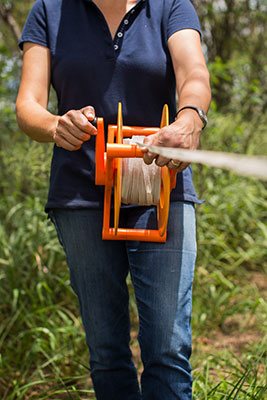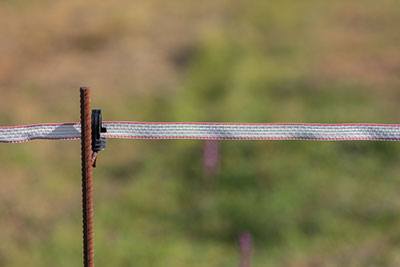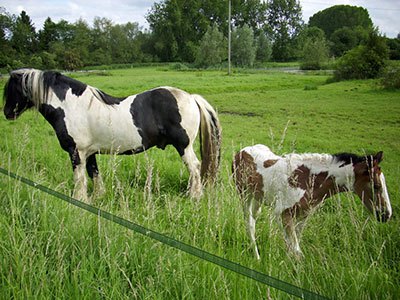If you’re looking for an effective and sustainable way to protect your property from intruders, the tapes are the perfect solution. This innovative product is becoming increasingly popular and keeps unwanted visitors off your land with minimal effort.
With this comprehensive guide on fence tapes, you’ll learn everything you need to know to make the best choice. Get ready to become an expert in no time!
Take away key points:
- Polytape is a great sign to contain cattle and create a physical and psychological barrier
- The tool comes in various sizes and colors to ensure the best safety standards
- It offers different benefits and disadvantages, so learn them all to choose the best solution for your needs
Table of Contents
Read our guide to learn all you must know about electric fencing poly tape. Find its benefits, use, and other crucial factors to help you choose the best solution.
What is the poly electric fence tape?

Polytape is a type of fencing that looks like a ribbon and is created with non-conductive polyethylene strands. Polytape is available in multiple widths (20mm electric fence tape, 40mm electric fence tape, etc.), and in different colors.
The thicker electric fence polytape is ideal for perimeter fence posts for horses and the extra wide electric fence tape is ideal for even stronger animals to keep them controlled while on the pasture.
For instance, white electric fence tape is ideal for higher visibility in greener and similar areas, while brown electric fence tape or black electric fence tape is an excellent option for snowy conditions.
The tool is embellished with conductive metal threads that carry voltage through the fence. Similarly to a wire-based electric fence, the livestock touching the polytape will receive a slight, corrective shock.
Why should you the ribbon electric fence element?
The electric ribbon fence element is an excellent choice for electric fencing due to several distinctive characteristics.
Firstly, the electric fence ribbon offers exceptional visibility to livestock, thanks to its wide profile and bright white or yellow coloring. Horses, in particular, benefit from this type of fencing due to its easy-to-spot nature.
Additionally, the polytape is lightweight, flexible, and easy to work with, making it a suitable option for temporary fencing.
Polytape is simple to install and can be repaired quickly as it requires only hand tensioning. Moreover, insulators can be fixed to posts either by sliding or screwing them in.
Despite having metal threads woven into the plastic ribbon, the polytape does not rust, and plastic and metal construction resists wear and tear.
Also, the polytape can withstand strong winds due to its fibrous lacing.
Different polytape sizes

The polytape sign is available in three different widths: half-inch, 1-inch, and 2-inch.
The width of the polytape you select depends on several factors.
For example, larger pastures should be protected with the 2-inch electric fence tape as it is more noticeable for livestock from afar. Using smaller widths could be ineffective since an animal could breach it before the corrective shock is received. Keep in mind the visual ability of each animal.
Half-inch and one-inch tapes can be used for animals that can easily distinguish the fencing as they get closer. Conversely, larger animals, especially cows, and cattle with inferior eyesight, are better off with the 2-inch version.
Finally, a 2-inch polytape is suitable for horses or similarly sized animals, whereas smaller animals will respond just as well to half-inch and 1-inch polytape.
Polytape is good for rotational grazing
Polytape fencing offers several advantages when implementing rotational grazing on your farm. One significant benefit is its easy and quick installation, which enables you to adjust paddock sizes and divide pastures efficiently.
Additionally, the polytape allows you to restrict access to resting paddocks and create grazing paths between paddocks. By using polytape, you can confine livestock to areas with high-quality forage growth, which is critical for rotational grazing.
What are the advantages & disadvantages of the polytape?
Poly tape is one of the most popular options available for electric fences on your farm, and it’s not hard to see why. However, like any other fencing option, polytape has its advantages and disadvantages.
Advantages
– Visibility: Polytape is highly visible due to its ribbon-like design, making it easy for animals to see and reducing the risk of injury.
– Durability: Made with non-conductive polyethylene and woven strands, polytape fence is strong and long-lasting.
– Easy to install: The lightweight and flexible design of polytape makes it easy to install and work with.
– Safe for animals and humans: The low-impedance design of polytape electric fencing ensures that animals won’t be seriously hurt or even killed in the event of contact.
Disadvantages
– Expensive: Polytape fences can be expensive compared to other electric fencing options.
– Susceptible to damage: Due to its woven design, polytape is susceptible to wear and tear. It can be cut easily, either accidentally or intentionally by animals.
– Requires maintenance: To ensure the longevity of your polytape, regular maintenance is required.
How to properly maintain your poly tape?

A polytape is a great way to keep your cattle safe and secure on your property. But like any other fencing system, it requires proper maintenance to ensure its longevity and effectiveness.
Here are some tips to help you maintain your polytape fence:
– Tighten the wire: Over time, the wires on your fence can become loose. Regularly tighten them to keep them taut and reduce the risk of predators getting through.
– Check the insulators: The insulators are responsible for holding the wire in place and preventing it from touching the fence posts. Check the insulators regularly to ensure they are in good condition and replace them if necessary.
– Clean the fence: Dirt and debris can accumulate on the fence, rendering it less effective. Clean your polytape regularly to ensure it’s free of dirt and vegetation.
– Test the voltage: The voltage is what keeps the predators away from the fence. Regularly test the voltage to ensure it’s at the correct level, according to the manufacturer’s instructions.
By following these simple maintenance tips, you can ensure that your polytape remains effective in keeping your animals safe and secure.
FAQs
How long does electric fence tape last?
It lasts longer than 25 years.
Can you use electrical tape on the electric fence?
Yes, you can. Take both ends of the break in your poly tape or wires and tie them as securely as possible. Leave just an inch or four centimeters of excess wires or tapes on both sides.
Can you join electric fence tape?
Yes, you can as the tool was made to join the horizontal ends together.
How do you attach electric fence tape?

Follow these steps:
– Attach it to the tensioner on the second end (corner post)
– Pull it tight
– Return to the first-line post and pull it tight with one hand
– Close the insulator with the other hand
How to repair electric fence tape?
Follow the steps below:
– replace the damaged section by splicing in a new section of tape.
– cut a section of tape that is longer than the damaged area.
– strip back the ends of the new tape to expose the conductors.
– overlap the damaged section of tape with the new section
– ensure the conductors are touching
– use a splicing tool or electrical tape to wrap and secure the splice
Conclusion
As you see, the polytape is an ideal option for your electric fences, and it will last longer for both temporary and permanent constructions. You can find its significant benefits and see why it’s so popular among farmers.
